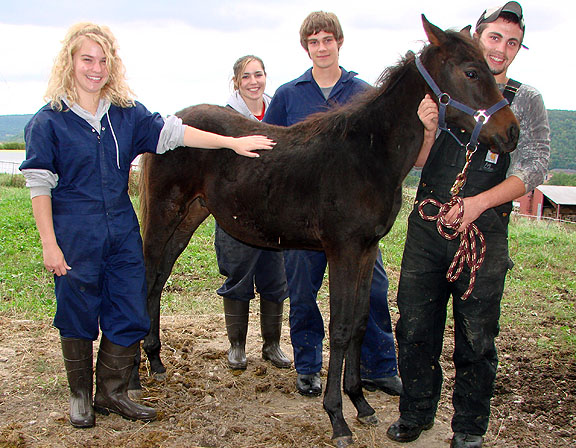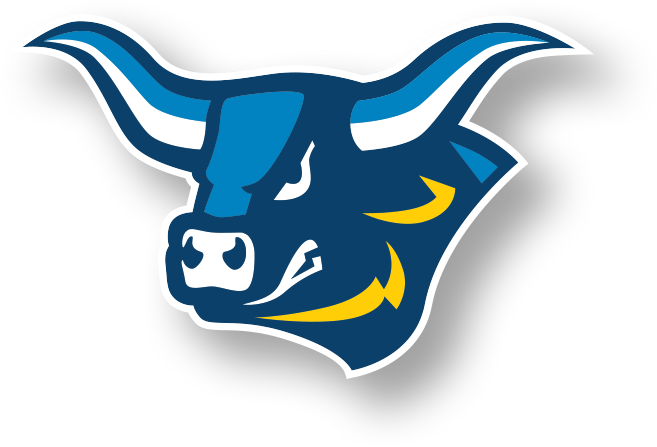At a glance

College's veterinary technology and agricultural technology programs received a
one-of-a-kind training experience during the fall semester that turned a tragic
beginning into a happy ending.

Students enrolled in Alfred State
College's veterinary technology and agricultural technology programs received a
one-of-a-kind training experience during the fall semester that turned a tragic
beginning into a happy ending.
Late in the summer, Wendy Dresser-Recktenwald, CEO of the board of the Humane
Society of Hornell, was notified by officials at the Finger Lakes SPCA/animal
control officers that a horse rescue operation was about to occur.
Marshalling her contacts, Dresser-Recktenwald identified and enlisted
horse-savvy folks who could serve as volunteers to help at the rescue
scene. Alfred State College's long history of service and responsiveness
to community needs was evidenced by the willingness of the ASC faculty and
students to help at the rescue. Included among these volunteers were
Victoria Bolton, SUNY Distinguished Teaching Professor and chair, Agriculture
and Horticulture Department; Jennifer Kuhn, ASC Pioneer Farm manager; Gina
Boyd, women's basketball coach and physical education instructor, and several
veterinary technology students who responded to the emergency call.
What they encountered when they arrived was far worse than any of them could
have imagined. Scores of emaciated and neglected horses were found on the
farm that had been entrusted to board and care for these animals on behalf of
their owners.
Horses were found to be suffering from all manner of maladies, including
malnutrition, thrush (rotting of the feet), rain rot (a fungal skin infection),
scratches (infections on their lower legs), eye infections, wounds that had not
been treated, lack of hoof care, compromised immune systems, and several types
of internal parasites.
Veterinarians and
other animal welfare workers spent two days examining and classifying the
horses, determining which horses should be placed where and what specific
therapy-if any-would be most effective in helping these horses.

students arrived to relieve the folks that had been on the frontlines since
early morning, making sure the horses had clean water and fresh hay.
These same students returned the next day to assist in any
way they could, working
cooperatively with the professionals and exhibiting compassion and maturity
beyond their years.
"I was so very proud of our students," notes Bolton. "They came without
being asked and pitched in wherever they could."
One of the biggest problems the rescuers faced was the number of horses that
had to be moved to foster homes. In the end, 80 horses were fostered out to a
variety of places throughout Western New York. The SPCA was in need of
additional foster homes for the horses. That is when Alfred State and the
Animal Welfare Institute stepped in to help foster some of the rescued
horses. Bolton requested help from the Animal Welfare Institute which
partners with ASC for the Pioneer Farm, who allowed the college to use the AWI
barn and AWI agreed to pay the bills on the ASC-fostered horses.
Ultimately, the college farm became the rehab center for two mares, their
respective foals, and four weanlings. Sound like a happy ending?
Not yet.
These horses, and their 72 counterparts, were fearful and despondent.
They had stopped trusting humans, had stopped expecting to eat, and, in fact,
some had given up the will to live.
"You could see it in their eyes," says Bolton. "They had given up."
Additionally, the young horses being fostered at ASC had never been handled by
people-never been on a halter, hadn't had medical attention, hadn't even had
their hooves trimmed by a farrier.
"You could see that it would take a lot of time and patience to rehabilitate
these horses," says Bolton.
The first thing that had to be done was to quarantine the visiting horses for
30 days until their infections could be cleared up and they could be vaccinated
so there would be no risk to the seven college horses being housed in a separate
area on the college farm. Students and faculty had to observe strict
bio-security measures to be sure that their boots or clothes did not bring
contaminants from one barn to another.
Chores with the college horses were done before chores with the rescued horses,
boots were scrubbed, clothing changed, and hands cleansed vigorously after the
rescued horses were tended to.
"Before the rescue horses arrived on the college farm, we could simulate the
need for bio-security measures," notes Bolton, "but knowing that observing
these practices could be a matter of life or death, really made an impact on the
students. This was something they will encounter in the ‘real world,' and
they will be ready."
Next, says Kuhn, the horses had to be fed, gradually, and by a certain
protocol.
"We couldn't give them rich hay or grain at first," she says, "because they'd
been starving for so long."
The horses have once again become accustomed to regular feedings, say Kuhn and
Bolton, but some of the horses still get protective of their food, even though
they've come a long way toward regaining their trust of humans.
"That, in large part, is due to the students who spent hours of their time
working with the horses, patiently letting them become accustomed to human
contact again," says Bolton.
Some students in the classes that worked with the rescue horses had not
previously had experience with horses, so they were "trained" on the college
horses-three full-size and four miniature-who are docile and friendly.
Then they started working with the rescue broodmares and foals. Those students
who were horse savvy interacted with the rescued horses sooner, and started
working with the weanlings and yearlings, "...exhibiting passion and compassion"
for these wounded animals, notes Bolton.
Despite the tragic circumstances that brought the horses to the farm, ASC
students learned a lot-not only about human-animal interaction and restoration
of trust, but also how to treat a variety of ailments, assisting with physical
examinations, vaccinations, blood draws, pregnancy checks, and minor surgeries.
"It was an experience we could not duplicate in the classroom or in the
laboratories," says Bolton. "There is no substitute for the first-hand,
hands-on experience our students had."
Kuhn cites an example of how much the students learned from the horses and how
much the horses learned from the students. A week after the horses
arrived at the college and the farrier came to trim the horses hooves, the
horses had to be sedated because they were so skittish around people and were
not used to being handled. Over the next several weeks, as the students
worked with the horses, they became
less fearful and more trusting, so that the second farrier
visit did not necessitate sedation
of the horses. But one horse still would not allow the farrier to lift
one foot. The student who had been working with that horse, and whom the
horse knew and trusted, lifted the horse's foot to allow the farrier to do his
work.
"This was because the horse trusted her and allowed the student to handle her
in a way a stranger could not," explains Kuhn.
"These students took this project on almost as a personal crusade," said
Bolton, "and they are all so proud of their accomplishments with those
horses. And I am proud of our students."
"This rescue could not have happened as smoothly as it did if not for the
involvement of Alfred State College," notes Dresser-Recktenwald. "We had
the right people at the right time. I'd also like to credit Vicki and Jen
for involving the Animal Welfare Institute who stepped up, allowing the use of
the AWI Pioneer Farm barn and footing the entire bill for the horses while they
are re-habbed at the college."
Bolton agrees that the college's involvement was important at the time of the
rescue and to help foster some of the horses. But, she adds, the students
benefited from this unfortunate circumstance, "so it was a win-win situation:
the horses healed and the students learned."
Now THAT's a happy ending!
